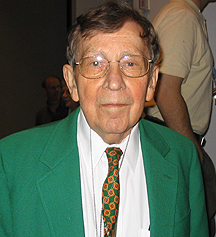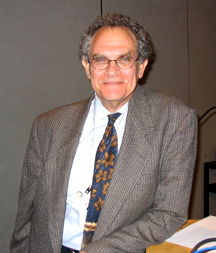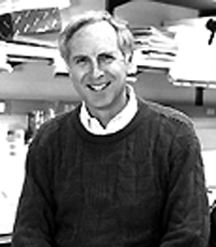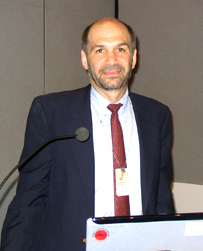
| T H E N I H C A T A L Y S T | J U L Y – A U G U S T 2005 |
|
|
|
|
by Karen Ross |
 |
|
Franklin
Neva: Scientist emeritus
|
On May 16, NIAID’s Laboratory of Parasitic Diseases (LPD) honored its newly retired long-time leader Franklin Neva with a symposium at which Neva’s former and current colleagues traced LPD’s (and Neva’s) history and presented ongoing research. The symposium was organized by LPD Deputy Chief Thomas Nutman, who co-moderated with LPD Acting Chief Alan Sher.
Neva served as chief from 1969 until 1995 and then as head of LPD’s Section on Opportunistic Parasitic Diseases. He officially retired in December of 2004, becoming scientist emeritus—and is still a familiar face around the lab.
The Early Days
Ted Nash was Neva’s first research fellow. He joined the LPD in 1970, a year after Neva became chief.
In 1969, Nash said, there was very little interest in clinical parasitology at NIH—and the lab was physically scattered, with sections in Georgia and Hawaii, as well as in Bethesda. Moreover, the scientists tended to focus on the biology of individual parasites rather than on parasite-human interactions, recalled Nash, who is now head of the Gastrointestinal Parasites Section.
There was, however, a growing need for a coherent clinical parasitology program because soldiers were returning from the Vietnam War suffering from parasitic diseases.
Neva’s early training prepared him well to take charge of LPD, said Nash. After medical school and internship, Neva spent a year and a half (December 1947 to July 1949) in Egypt working at the Naval Medical Research Unit-3 on typhoid fever and schistosomiasis.
Three years of research fellowships at Harvard followed—the first working on rickettsiae with John Snyder and the next two in the lab of John Enders, where he learned techniques of growing viruses in tissue cultures. At this time, he described an exanthem disease (Boston rash) caused by an Echo virus.
After an academic appointment in the lab of Jonas Salk, he returned to Harvard to work in the newly created Department of Tropical Public Health with Tom Weller. It was here in the early 1960s that Weller and Neva isolated and propagated rubella (German measles) virus.
It was also at Harvard that Neva applied tissue culture techniques to the study of intracellular parasites and honed his clinical parasitology skills.
 |
 |
 |
|
Ted
Nash
|
Lou
Miller
|
Thomas
Nutman
|
The Neva Decades
Upon his arrival at NIH, Neva consolidated the LPD in Bethesda and emphasized research on the molecular biology of parasites and the human immune response to parasitic infection.
In 1971, he hired Louis Miller, currently head of the Malaria Vaccine Development Branch, who established the malaria research program. Before long, said Nash, "LPD was second to none" in clinical parasitology.
Miller, whose malaria research was a key factor in LPD’s rise to preeminence, peppered his talk on malaria—host cell interactions with anecdotes about Neva and the practice of clinical research in the early days of LPD.
People, Places, Parasites
The wide range, both geographic and scientific, represented by the other scientists who described their research at the symposium was a testament to the impact that Neva has had on the field of parasitic diseases.
Some of them—including Peter Weller (Harvard Medical School, Boston), Josh Berman (NCCAM), Gary Weil (Washington University, St. Louis), David Freeman (University of Alabama School of Medicine, Birmingham), Chris Karp (University of Cincinnati), Peter Melby (University of Texas Health Science Center, San Antonio), and Christopher King (Case Western Reserve University, Cleveland)—spent just a few years in the LPD during their training.
Others, such as Eric Ottesen (Emory University, Atlanta), were part of LPD for decades but then moved elsewhere.
Still others, such as Amy Klion, David Sacks, and Tom Wellems, are current NIAID researchers.
And representing two of the many scientists the world over with whom Neva collaborated were Barbara Herwaldt (CDC) and Edgar Carvalho (Universidade Federal da Bahia, Salvador, Bahia, Brazil). The parasites they study include single- celled organisms, such as Plasmodium (the malaria agent), Leishmania, and Cyclospora; and worms, such as schistosomes, strongyloides, and filariae.
Projects
They work at the bench, at the bedside, in the field, and everywhere in between. Weller studies the molecular function of eosinophils, immune cells that are critical for fighting parasitic infections but that also contribute to airway inflammation in people with asthma.
Ottesen is working on a campaign to eliminate lymphatic filariasis by treating the entire at-risk population in Africa with parasite-killing drugs.
Herwaldt is a detective: She helped pinpoint raspberries from Guatemala as the source of Cyclospora that sickened people in the United States in 1996.
Praise
All of them talked about how Neva’s insights and enthusiasm had inspired their research. Weil, who works on the diagnosis and treatment of filaria infection, said he had Neva’s scientific spirit in mind when he developed an overseas research program for Washington University medical students.
Sacks stressed Neva’s generosity, noting he was allowed to experiment with Neva’s precious collection of Leishmania strains, even when he was a very inexperienced member of Neva’s lab.
Ottesen emphasized Neva’s leadership—of people and of projects.
Miller urged Neva to continue
to be a frequent visitor. "The young people need you," he said, "and
a few of us old guys also love to talk to you."
![]()